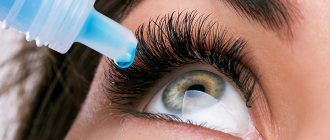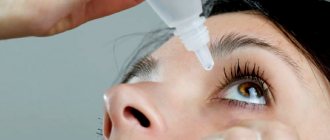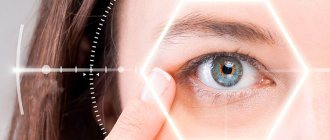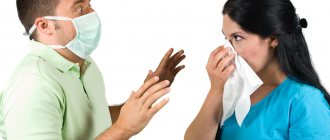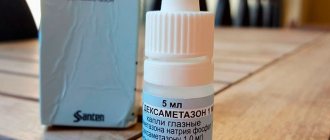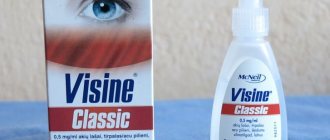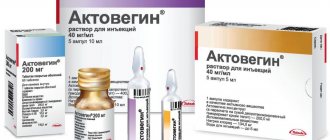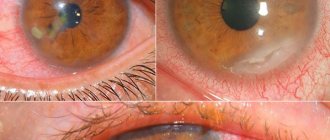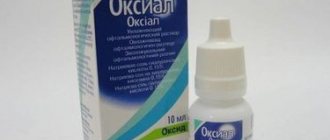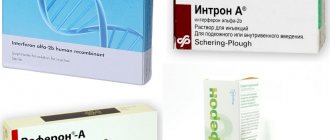Blepharitis is a group of diseases associated with inflammation of the ciliary margin of the eyelids, predominantly of infectious or allergic origin, prone to long-term progression and frequent relapses. The disease is difficult to treat and can sometimes cause infection of the eye and weakened vision.
With blepharitis, the eye as a whole may remain unchanged, which often leads to the mistaken belief that the disease is trivial and does not require treatment. In fact, this is not the case, and with long-term blepharitis, the eyes are constantly exposed to infection, which can cause significant problems, including deterioration of vision.
Reasons for development
Usually the disease is caused by an infectious (bacteria, fungi, mites) or allergic agent. Blepharitis can be caused by various reasons, but whatever the immediate cause of inflammation of the eyelid, reduced immunity, as a result of recent or existing general diseases, is of paramount importance in the development of blepharitis.
Possible reasons:
- Long lasting stye of the eyelid;
- Allergic conditions, anemia and vitamin deficiency;
- Application of cosmetics (mascara);
- Prolonged exposure to the sun, in dusty rooms;
- Astigmatism, myopia, farsightedness;
- Demodicosis of the eyelids;
- Diseases of the digestive system;
- Autoimmune lesions caused by chronic foci of inflammation: carious teeth, sinusitis, inflammation of the genitourinary system.
The main cause of blepharitis in children is Staphylococcus aureus (when the body is weakened). Less commonly, pathology develops due to factors such as:
- hypothermia;
- getting dust and other mechanical particles into the eyes;
- high load on the nervous system;
- physical stress;
- infectious diseases;
- reduced immunity;
- diabetes;
- metabolic disorders;
- helminthic infestations;
- allergy;
- chronic pathologies of the gastrointestinal tract (gastrointestinal tract).
Blepharitis can also occur due to negative environmental influences (increased levels of dust and smoke in the air, prolonged exposure to chemical compounds in the atmosphere).
What is the prognosis for blepharitis?
Blepharitis is a type of disease in which relapses can often occur. The most difficult treatment is for blepharitis caused by staphylococcus. This pathology is characterized by the fact that barley, chalazion, trichiasis may appear on a regular basis, deformation of the eyelid margins, chronic conjunctivitis and keratitis may occur. Most often, acute blepharitis has a positive effect from therapy, but chronic blepharitis can also develop. The latter is a sluggish, relapsing and treatment-resistant disease. During exacerbations, discomfort and cosmetic defects occur, but usually there is no corneal scarring.
Symptoms
Inflammatory lesions of the eyelids are quite easily confused with stye, eyelid abscess, conjunctivitis, keratitis or other eye diseases. Blepharitis is usually indicated by a number of characteristic symptoms, which help distinguish it from other diseases. However, only an ophthalmologist can make a final diagnosis after a full examination.
Typical signs of blepharitis:
- thickening, swelling and redness of the edges of the eyelids;
- the appearance of purulent or serous discharge;
- sticky eyelashes that prevent you from opening your eyes in the morning;
- the presence of crusts at the roots of the eyelashes;
- the formation of small ulcers on the edges of the eyelids;
- accumulation of foamy discharge in the corners of the eyes.
Characteristic signs of blepharitis (see photo) depending on the type:
| Simple. | It is characterized by redness of the edges of the eyelids, their slight thickening, dilation of the ducts of the meibomian glands, slight redness of the conjunctiva of the eyes and the presence of a grayish-whitish secretion in the corners of the eyes. |
| Ulcerative. | It is characterized by inflammation of the eyelash follicles with the surrounding glands and the formation of purulent secretion in these “pockets”. The main reason is the entry of a bacterial infection into the hair cavities, especially Staphylococcus aureus. The site of infection becomes inflamed, crusts appear, and when peeled off, ulcerated skin is visible, which then scars. It can also lead to impaired eyelash growth, whitening and the appearance of wrinkles on the eyelids. |
| Scaly or seborrheic. | It is characterized by redness and thickening of the edges of the eyelids, itching and the formation of small scales at the base of the eyelashes, tightly adjacent to the edges of the eyelids, consisting of desquamated particles of the epidermis and formations of the sebaceous glands (Meibomian, Zeiss). Often accompanied by seborrheic dermatitis. |
| Demodectic. | It is characterized by severe itching, pain in the eyes, sticky secretion on the edges of the eyelids, as well as hyperemia, thickening and the appearance of dry crusts between the eyelashes. The reason for this is infection of the hair follicles by the Demodex mite, which feeds on the secretions secreted by the sebaceous glands. |
| Rosacea. | It is characterized by the appearance on the skin of the eyelids of small grayish-red rashes with pustules. Usually this process is accompanied by the presence of rosacea in the patient. |
| Meibomian. | It is characterized by ultra-high production of secretion by the meibomian glands, which is practically not excreted, which is associated with the blocking of the excretory ducts of the sebaceous glands. In this regard, seals are visible in the place of blocked ducts, and the eyelid at the edges may expand slightly. There is hyperemia. |
| Stye on the eye. | It is characterized by the formation of purulent contents in the ciliary or meibomian pockets, accompanied by spherical swelling, hyperemia, itching, swelling of the eyelid, and the sensation of a foreign body in the eye. If severely affected, the body temperature may rise and headaches may appear. The main cause is infection of the ciliary or meibomian pouches with a staphylococcal infection. |
| Allergic. | It is characterized by inflammation of the mucous membrane of the eyelid, redness, swelling, lacrimation, itching, photophobia, pain in the eyes. The main reason is a reaction to dust, chemicals, pollen, animal hair, medications (medicinal blepharitis), etc. Usually diagnosed during the flowering period. |
By localization they distinguish:
- Anterior marginal blepharitis - characterized by damage to only the ciliary edge of the eyelid;
- Posterior marginal blepharitis - characterized by damage only to the meibomian glands with their ducts;
- Angular blepharitis (Blepharitis angularis) is characterized by an inflammatory process mainly in the corners of the eyes.
It should be noted that different types of blepharitis are treated in completely different ways. Therefore, it is highly undesirable to take any measures on your own. It is better to start treatment after consultation with an ophthalmologist. Only a specialist can make the correct diagnosis and select the most effective treatment.
Self-treatment
Warm compresses will help get rid of blepharitis faster. Treatment is carried out using a cotton pad moistened with warm water. A homemade compress must be brought close to the inflamed eyelid and held there for 4-5 minutes. Heating the eyelids promotes secretion production. The increased temperature “melts” the dried fatty crusts that clog the meibomian glands. When heated, the outflow of fat improves. This prevents clogging of the glands in the future.
Massage is another method that will be an excellent addition to the main treatment. It will be ideal if it can be combined with the application of warm compresses. Massaging the eyelids will allow fat deposits to come out faster and free the ducts of the meibomian glands. Lightly press on the edge of the eyelid, then slide your finger from bottom to top along the lower eyelid and vice versa. You shouldn't get carried away with massage either. This may lead to irritation.
Eyelid peeling will help speed up conservative treatment. With its help you can get rid of excess sebum and atrophied cells. For this purpose, you should use a cotton swab. She needs to gently rub her eyelids parallel to the lash line. Baby shampoo is suitable as a scrub. It must first be diluted, for example, in the proportion of 5 drops of shampoo per standard glass of water.
Remember that treatment should only be prescribed by a doctor. Do not resort to self-treatment without consulting a specialist.
Diagnostics
Diagnosis of blepharitis is based on an external examination of the eyelids, as well as instrumental and clinical diagnostic methods.
During an external examination of the eyes, redness and thickening of the edges of the eyelids, dilation of blood vessels, the release of purulent secretion and the appearance of characteristic scales and crusts are determined. In case of demadecotic tissue damage, a special examination of the eyelashes is necessary, in case of a disease of infectious origin - taking a smear from the conjunctiva to determine the causative agent, in case of an allergic form of blepharitis - allergy tests and consultation with an allergist.
Additionally, tests are performed to determine visual acuity, and in some cases, tissue biopsy to exclude a malignant process in the sebaceous glands.
Diagnosis of posterior and anterior (marginal) blepharitis
Both types of the disease are diagnosed like any other type. It is worth noting that posterior marginal blepharitis appears later than others, but it will not be difficult for a specialist to detect it immediately. First of all, the tuberosity of the inner surface of the eyelids is visible, as well as redness of the mucous membrane and swelling. When examining the condition of the meibomian glands, a white-gray coating will be visible. This is the exudate of the internal fluid filling the glands. If the patient undergoes a routine examination, the ophthalmologist will listen to his complaints and review his medical history. If blepharitis is suspected, your doctor will perform a slit-lamp examination to examine the structures of the eyeball.
Often, to establish a diagnosis, it is necessary to conduct a laboratory analysis of the glandular tissue and fatty deposits that cause blockage of the ducts. Also, for an accurate diagnosis, the ophthalmologist can send you to an allergist-immunologist.
Complications
If you are diagnosed with blepharitis, be prepared for complications of the disease. They are especially pronounced in children. Frequent consequences:
- impaired eyelash growth;
- barley;
- dry eyes;
- blepharoconjunctivitis;
- keratitis;
- corneal injury;
- discomfort when wearing contact lenses;
- chalazion;
- decreased vision;
- secondary glaucoma;
- inflammatory processes;
- scleritis;
- scars on the dermis of the eyelids.
Why is blepharitis dangerous?
If it is severe and treatment is not started in a timely manner, it can cause keratitis. With this disease, the cornea becomes inflamed. Over time, it becomes cloudy, which leads to severe deterioration of vision. Sometimes a person loses it completely. This happens rarely. The main thing is not to let the disease progress.
Relapses of chronic blepharitis can be avoided. A number of rules should be followed:
- maintain hygiene;
- Clean your home more often and ventilate rooms where you stay for a long time;
- select correction products together with an ophthalmologist;
- scheduled replacement contact lenses;
- eat right, give up bad habits;
- vitamins and strengthen the immune system;
- At the first signs of illness, see an ophthalmologist.
How to treat blepharitis?
Full recovery usually requires a fairly long period (at least a month). Treatment of blepharitis is complex, it includes both systemic therapy measures and external therapeutic methods.
The most important task is to eliminate the cause of the disease, which is achieved through:
- sanitization of foci of infection;
- changing diet;
- maintaining body hygiene at home and at work;
- therapy of allergic pathologies;
- correction and treatment of other eye diseases;
- elimination of helminthic infestations, etc.
Having established the type of blepharitis, the doctor selects the necessary methods of drug treatment. Frequently used drugs are antibiotics, sulfonamides, corticosteroids, antiseptics, antihistamines, vitamins, mineral complexes, immunocorrectors.
A complete change in diet may be required, as well as autohemotherapy.
The list of drugs for external use also depends on the type of blepharitis.
Eye ointments are applied in this way: using the left hand, the lower eyelid is pulled back to expose the conjunctiva. An ointment, gel, or cream is applied with a special glass rod, which is in the right hand at this moment. Next, the patient closes the eye and lightly massages the eyelid (10-20 seconds).
Ulcerative blepharitis
The resulting crusts on the eyelids must first be lubricated with a softening ointment or 1% Syntomycin emulsion. Using a cotton swab treated with an antiseptic, remove the softened crusts and purulent discharge from the wound. A complex ointment containing an antibiotic is applied to the edge of the eyelids:
- Dexa-Gentamicin
- or other complex ointment Maxitrol.
Process 2-3 times a day. Limit the entry of dust into the wound as much as possible. Maintaining normal hygiene will speed up the recovery process. It is also necessary to strengthen the body with a vitamin complex to strengthen the immune system.
Scaly (seborrhea) blepharitis
Therapy of this blepharitis is a very labor-intensive process, requiring not only general, but also local treatment. Local therapy refers to medicinal ointments that are applied to the lesions and solutions for instillation of the eyes. First, the edges of the eyelids are treated with 10% Syntomycin emulsion to soften the scales.
Next, they are treated with an antiseptic (Sulfacil - sodium, brilliant green), and only then a medicinal ointment is applied on top. The composition of surface-use products for the treatment of blepharitis includes antibiotics and sulfonamides. Ointments such as:
- Fucidin;
- Tetracycline ointment;
- Dibiomycin;
- Chloramphenicol.
In rare cases, ointments with glucocorticosteroids (Hydrocortisone, Pimafucort) are prescribed. Sometimes a combination of Dexamethasone and Gentamicin ointments works well.
In complex treatment, solutions are used:
- Tsipromeda;
- Desonida;
- Zinc sulfate;
- Prednisone.
These drugs are used to treat the conjunctival cavity by drip. Following simple hygiene rules will help prevent not only this infection, but many others.
Demodectic blepharitis
For treatment, it is first necessary to reduce the activity of Demodex mites, which infect the eyelash bulbs. In order to disrupt their life cycle and the possibility of reproduction, it is necessary to thoroughly clean the living space, wash the bed linen, and maintain normal hygiene. 2-3 times a day, wipe the eyelids with a sterile swab, generously moistened with baby shampoo, diluted with saline solution in a ratio of 1 to 1.
Lubricate the affected areas of the eyelids with special eye ointment hydrocortisone-POS 2.5%. It is advisable to alternate use with Dex-gentamicin ointment. Before going to bed, be sure to generously apply ointment to the edges of the eyelids - this will make it possible to reduce the ability of mites to reproduce and further destroy them.
Meibomian blepharitis
Inflammation of the meibomian glands located in the cartilage. In 80% of patients, this infection is accompanied by conjunctivitis, which leads to an erroneous diagnosis. To prevent further inflammation, it is necessary to remove purulent discharge and treat the edges of the eyelids with anti-inflammatory ointment:
- Dancil;
- Ofloxacin;
- Phloxal.
Repeat these procedures 3 times a day. With visible improvement, the procedures are reduced in number of times.
Eye drops are prescribed, Natural Tear , which moisturizes the cornea and conjunctiva to reduce burning of the eyelids.
Angular blepharitis
First of all, you need to remove purulent discharge from the eye, from the corners of the palpebral fissure, with a swab moistened with baby shampoo, diluted with saline in a ratio of 1 to 1, and treat the inflamed edges of the eyelids with 1% Sulfur-zinc ointment. Clean and treat the edges of the eyelids 1-2 times a day. Observe general hygiene rules. It is recommended to take a course of taking a vitamin complex to strengthen the immune system.
The use of tablets in treatment
Tablets are considered a less effective method of therapy for a disease such as marginal (posterior) blepharitis. They are absorbed more slowly by the body compared to other medications. Therefore, the healing process is delayed. The list of the most common drugs in the treatment of marginal (posterior) blepharitis includes the following:
- "Furosemide";
- "Veroshpiron";
- "Triphas"
The purpose of taking the tablets is to relieve puffiness from the eyes. Medicines should be used strictly according to instructions. They have contraindications and side effects. Usually, ophthalmologists recommend taking pills in the initial stages of the disease. In most situations, doctors prescribe taking one tablet 2 times a day. In rare cases, the dose may be increased.
Treatment at home
Precautions when treating blepharitis at home:
- mandatory compliance with hygiene rules during various procedures on the eyes, hands must be thoroughly washed (both before and after manipulations), cotton swabs and solutions for treating the eyes must also be used sterile;
- You should not further injure your eyelids, scratch them, use cosmetics or harsh soaps; when wiping your eyes, it is undesirable to use gauze and bandages;
- treatment of blepharitis should begin immediately after the first symptoms appear;
- if you have problems with vision or pain in the eyeballs, do not delay going to the ophthalmologist;
- if any allergic reactions to the use of medicinal or herbal remedies occur (increased itching, swelling, rashes on the eyelids and face and other symptoms), you should immediately rinse your eyes with warm water, stop using the drug and consult a doctor;
- when treating blepharitis, in addition to local treatment, you need to increase the body's defenses: take vitamins, a balanced diet, giving up bad habits, hardening, physical activity, and, if necessary, drugs that increase immunity (Immunal, Echinacea, Thymolin, Uracil and others);
- If you do not treat diseases that increase the risk of developing blepharitis, then inflammation of the eyelids will soon return (anthelminthic therapy, sanitation of the oral cavity, control of blood sugar levels, treatment of chronic diseases of the nasopharynx, vision correction with glasses or lenses, and so on).
Treatment principles:
- If possible and necessary, eliminate the cause that led to the development of blepharitis (avoid contact with allergens, treat seborrhea, and so on),
- Thorough eye treatment with antiseptics and anti-inflammatory solutions, washing with baby soap or shampoo, using hypoallergenic moisturizing eyelid creams,
- The use of ointments and drops containing antibiotics, depending on the pathogen and according to the antibiogram, antiallergic components,
- Eyelid massage and physical therapy significantly reduce the risk of exacerbations.
- A diet rich in vitamin A (carrots, corn oil, citrus fruits, egg yolks and other colorful foods), B vitamins (greens, cabbage, potatoes, nuts, etc.), vitamin D and calcium (dairy products, sun exposure, etc. ).
What else do you need to know about treating blepharitis?
Taking vitamins is extremely useful. Regular consumption will be especially beneficial:
- retinol (vitamin A);
- riboflavin (B vitamin);
- ascorbic acid (vitamin C).
It is best to take these vitamins in their original form. Retinol is found in fish oil, liver and kidneys. Rich in this substance: wild garlic, broccoli, garlic, viburnum berries. To ensure that the body does not experience a deficiency in riboflavin, you should more often consume pork or beef liver, cod liver or quail eggs. Vitamin C is contained in citrus fruits: orange, lemon. There is a lot of it in rosehip, dogwood, rowan and sea buckthorn. Biological supplements and vitamin complexes also give good results.
Not only vitamins, but also elements such as zinc and selenium will have a beneficial effect. Seafoods, such as kelp or shrimp, are rich in zinc, as well as cheeses and soy. Selenium is found in nuts, legumes, and some cereals, such as buckwheat. By following a diet that includes the consumption of these foods, the healing process will be faster.
Folk remedies
We have a huge variety of different recipes open to us. Moreover, you don’t have to go to the field and look for the right plant there, you just need to go to the pharmacy and buy the right herbal mixture. But it must be remembered that any treatment, even with folk remedies, requires the correct diagnosis of the disease or infection.
- Bird cherry infusion is used to rub the eyes in case of acute conjunctivitis, and as a mouth rinse for stomatitis. Due to the high content of amygdalin, the berries are used without seeds. 60 gr. Flowers are poured into 300 ml. Boiling water, leave for 10 hours in a steam bath, filter through gauze and apply to the eyes 2-3 times a day. Contraindications for women with signs of pregnancy, as well as those who have a contraceptive effect.
- Tea lotions: pour boiling water over tea bags and apply them to your eyelids for 20 minutes. Reduces inflammation, soothes itching.
- Apply syntomycin ointment to the edges of the eyelids 3 times a day until the condition completely improves.
- The remedy is especially effective for scaly blepharitis. Bring corn oil to a boil, wait until it cools, lubricate the edges of the eyelids 3 times a day.
- For purulent eye infection. Wash your eyes daily with a 2% aqueous solution of boric acid, and apply lotions with fresh (boiled) cottage cheese before going to bed. This method has its drawbacks. With constant use, acute poisoning of the body, vomiting, diarrhea, headaches, and convulsions occurs.
- Infusion of thyme with chamomile. This collection is a very strong anti-inflammatory agent. Apply lotions 3-4 times a day. There are no contraindications for use, with the exception of a selective allergic reaction.
- Laundry soap works well against Demodex mites. Soap foam is applied to the affected area, after 3-5 minutes it is washed with water and lubricated with Vaseline.
- Ulcerative blepharitis is well treated with an infusion of celandine herb. Pour 2 tablespoons of herbs with a glass of boiling water and let stand for 2 hours. The infusion is ready.
- Scaly blepharitis can be cured with burdock oil; the affected areas of the eyelids are generously lubricated at night.
- To heal wounds on the edges of the eyelids, you can use fresh aloe juice.
- Thyme herb in the amount of 2 teaspoons, pour 150 ml. Boiling water, leave the resulting decoction for 1.5 hours. Has an antibacterial effect. Wipe your eyes with the solution morning and evening.
- Cook 1 onion over low heat for 40 minutes in 0.5 liters of water, strain through a colander. Rinse your eyes with the resulting decoction every 2-3 hours. Healing agent.
- Boil 12 small bay leaves in 0.25 liters of water for 3 minutes. An effective remedy for allergic blepharitis.
- Herbal mixture for eye baths - take chamomile, string grass and calendula leaves in equal parts. 2 tablespoons of the resulting mixture, pour 170.0 ml of boiling water and place in a water bath for 10 minutes, preferably leave for 1-2 hours. Cool, moisten sterile cotton swabs and apply to eyelids for 25 - 35 minutes. This collection is an anti-inflammatory and antiseptic, helps with various forms of blepharitis.
- The method is not for the picky. We take our urine, moisten a cotton or gauze swab generously, and place it on the eyes. At this moment, try to blink so that the liquid gets onto the infected areas or wounds. This method does not require any special preparation. Very effective.
Treatment with antibiotics
The use of medications for internal use is a less effective method of therapy. Ophthalmologists prescribe them less frequently, as they prefer to treat the marginal form of blepharitis in a hospital setting. Antibiotics are most often prescribed, mainly tetracyclines. These are medications such as:
- "Tetracycline";
- "Minocycline";
- "Doxycycline";
- "Oxytetracycline";
- "Chlortetracycline."
For severe inflammation, ophthalmologists recommend a short but intensive course of treatment. An antibiotic is usually prescribed, for example Tetracycline, at a dosage of 250 mg. It must be taken 4 times a day. The duration of treatment is determined individually. The general course should not be more than 14 days. Tetracycline antibiotics have a number of contraindications. They are not prescribed if the patient is prone to allergic reactions. These antibiotics are not suitable for those who have serious problems with the liver and kidneys. It is not customary to prescribe them to pregnant and lactating women.
Blepharitis in children
Blepharitis in children develops if the skin of the eyelids is thin, and the deeper tissues are loose and contain little fat. The disease can go unnoticed for a long time, so treatment often begins when the pathological process is already in full swing.
The most common cause of pathology is the active reproduction of Staphylococcus aureus with a general weakening of the body.
Factors that provoke the disease in a child are:
- hypothermia;
- decreased general immunity;
- past infectious diseases;
- physical or nervous stress;
- chronic diseases of the digestive system;
- diabetes;
- helminthic infestations;
- allergic reactions;
- various metabolic disorders;
- contact with mechanical particles in the eyes;
- the presence of chronic foci of infection (sore teeth, inflamed tonsils, etc.).
If blepharitis is diagnosed, the baby, in addition to the medication prescribed by the doctor, needs to adjust the diet (in some cases, a special hypoallergenic diet is indicated). Physiotherapeutic techniques are widely used, including ultraviolet irradiation, ultra-high frequency therapy (UHF), magnetic therapy and electrophoresis with solutions of vitamins and antibacterial agents.
Antibacterial eye ointments such as Colbiotsin, Oriprim-P and Oftalmotrim have proven their effectiveness. Eye drops are also widely used - sodium sulfacyl solutions, Picloxidin and Miramistin.
Among herbal remedies for topical use, chamomile decoction and calendula tincture, which are characterized by a pronounced anti-inflammatory effect, are recommended.
Anterior marginal blepharitis. Characteristic
Unlike posterior blepharitis, anterior blepharitis affects the outer part of the eyelid - the place where the eyelashes grow. Experts say that anterior blepharitis (marginal) is caused mainly by staphylococcus or dandruff.
Also among the causes of such anterior blepharitis are:
- seborrheic, which is characterized by hyperemia and greasy coating, sticky eyelashes;
- severe chronic, which can lead to hypertrophy and scarring of the eyelid margin.
The presence of vitamin deficiency, helminthic infestation and eyelash mites can also cause anterior marginal blepharitis.
Forecast
Most blepharitis has a constant course and will periodically remind the patient of its existence. Only the ulcerative and demodectic forms can be completely cured, but there is always a risk of their re-development. To prevent this from happening, you should pay attention to your lifestyle and the state of your immune system. To prevent recurrence of eyelid lesions, the following measures are recommended:
- Rejection of bad habits. Both smoking and frequent drinking of alcohol negatively affect the entire body. In particular, these substances damage liver cells, which neutralize various toxic substances, blood-forming organs and skin. All this leads to a decrease in human protection from harmful external factors;
- Treatment of chronic diseases. Any pathological process in the body (infectious or non-inflammatory) leads to a strain on our adaptive capabilities. To put it simply, tissues constantly arrive under a kind of “stress” and “overwork.” Therefore, it is important to promptly identify your diseases and treat them adequately;
- Daily facial hygiene. By mechanically removing sebum and some microbes, we maintain the dermis in a normal state and allow it to fully perform its functions;
- Lifestyle correction. Excess weight, constant stay in one position, regular stress, lack of proper rest - all these factors reduce a person’s stability. It is important to correctly prioritize your health and your daily habits/activities. Changing them for the better will improve the condition of the body, and therefore the quality of life.
Despite the fact that blepharitis is not a life-threatening disease, it must be treated in a timely manner, without delaying therapy indefinitely. The sooner you start fighting the pathology, the lower the risk of its chronicity. Consequently, the better the prognosis for the person and his state of health.
Conjunctivitis Eye keratitis: photos, symptoms and treatment Glaucoma Increased intraocular pressure: symptoms, causes and treatment Ophthalmoferon Hepatitis C: first signs and treatment regimen
Symptoms and types
Before starting treatment for blepharitis with folk remedies, it is important to determine the symptoms. Indeed, often due to ignorance of the symptoms of pathology, people do not pay attention to the problem in time, as a result complications appear.
What manifestations should you pay attention to:
- itching begins in the eye area;
- eyelids become heavy;
- Eye fatigue is constantly observed, even after sleep;
- any lighting seems too bright;
- swelling and redness appear at the edges of the eyelids;
- dandruff appears on the eyelashes, scales appear on the eyelids;
- eyelashes constantly stick together and grow in the wrong direction, falling out a lot;
- The eyes are tormented by tearing and pain.
In most cases, both eyes are affected. In order not to confuse the disease with another, you can look at photos of blepharitis symptoms before starting treatment.
There are four types of blepharitis:
- ulcerative;
- angular;
- demodectic;
- scaly.
The ulcerative form is the most severe, and scaly blepharitis is often diagnosed.
Physiotherapeutic procedures
To get rid of such a disease, you need to use an integrated approach, namely, combine medications and physical therapy. It strengthens the body and helps relieve inflammation from the mucous membrane of the eye.
If allergic blepharitis has worsened, then they resort to the following physiotherapeutic procedures:
- Electrophoresis - eliminates infection in the conjunctiva and helps improve immunity.
- Darsonvalization - helps eliminate inflammation of the eyelids and stops eyelashes from falling out.
- UHF therapy improves blood circulation in the affected eyelids, thereby accelerating the epithelization process.
In some cases, UV therapy is used for prevention purposes. It helps speed up the regeneration processes of the eyelid skin and eliminates pathogenic microorganisms in the mucous membrane of the eye.
